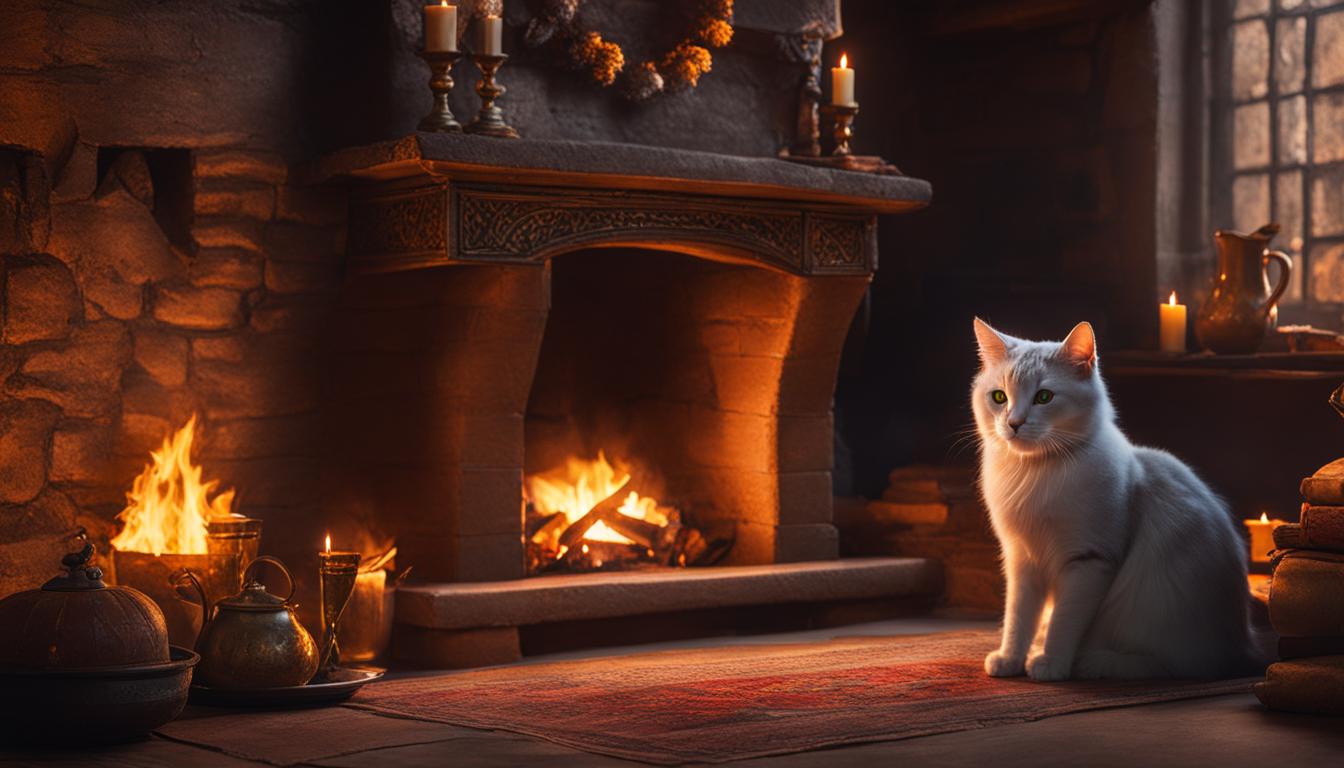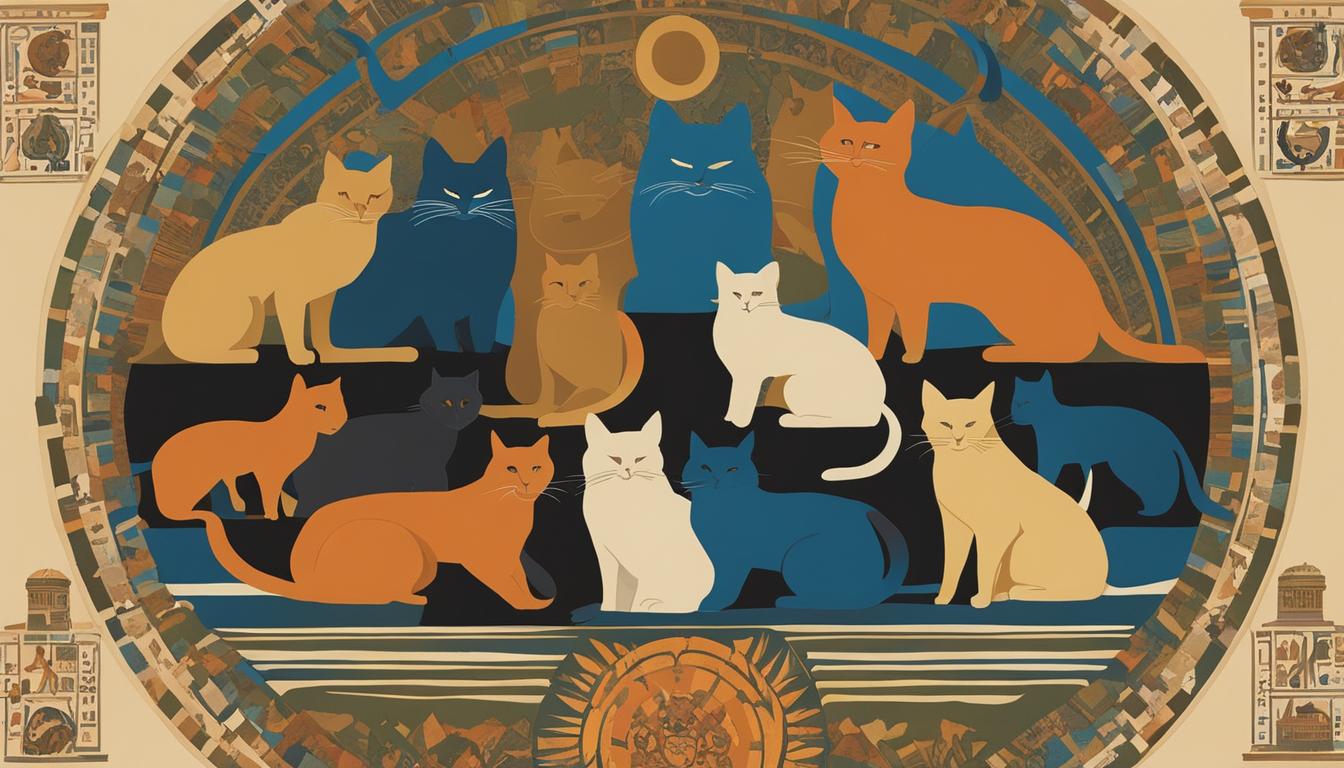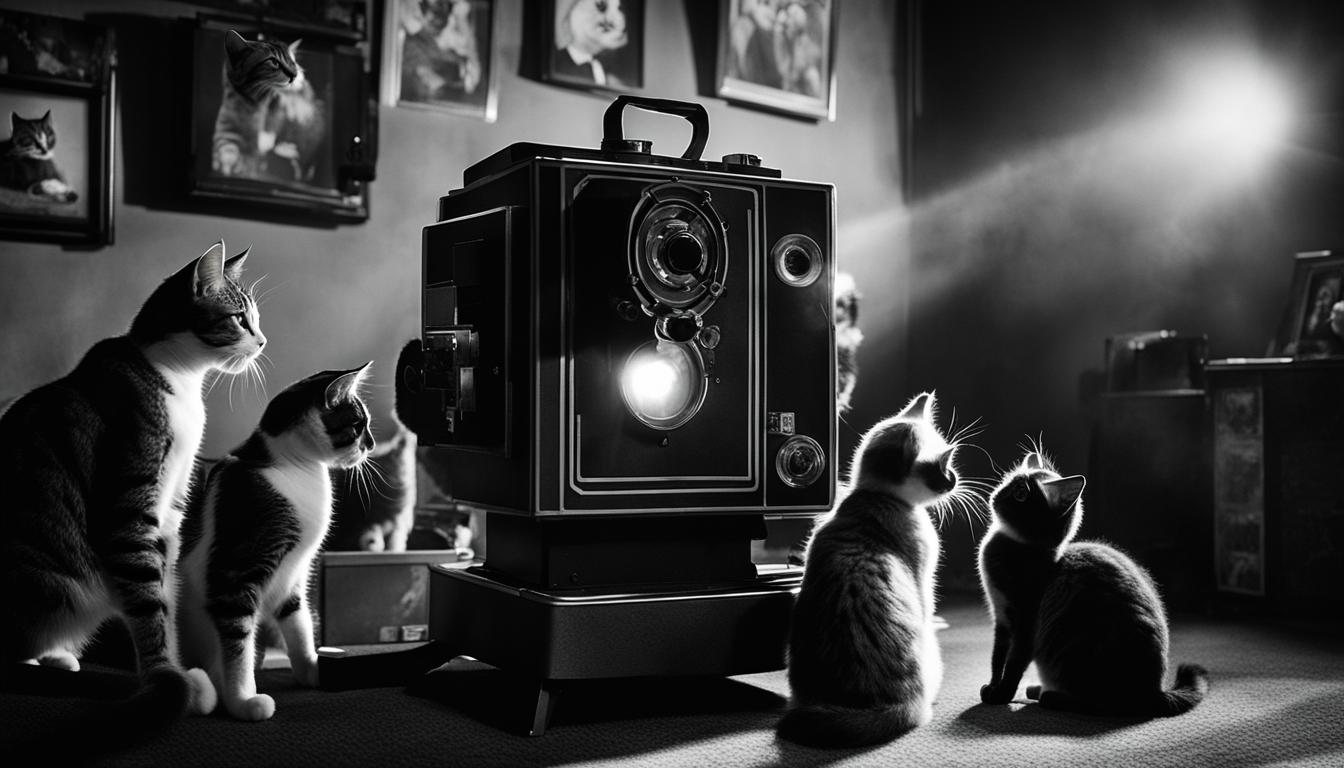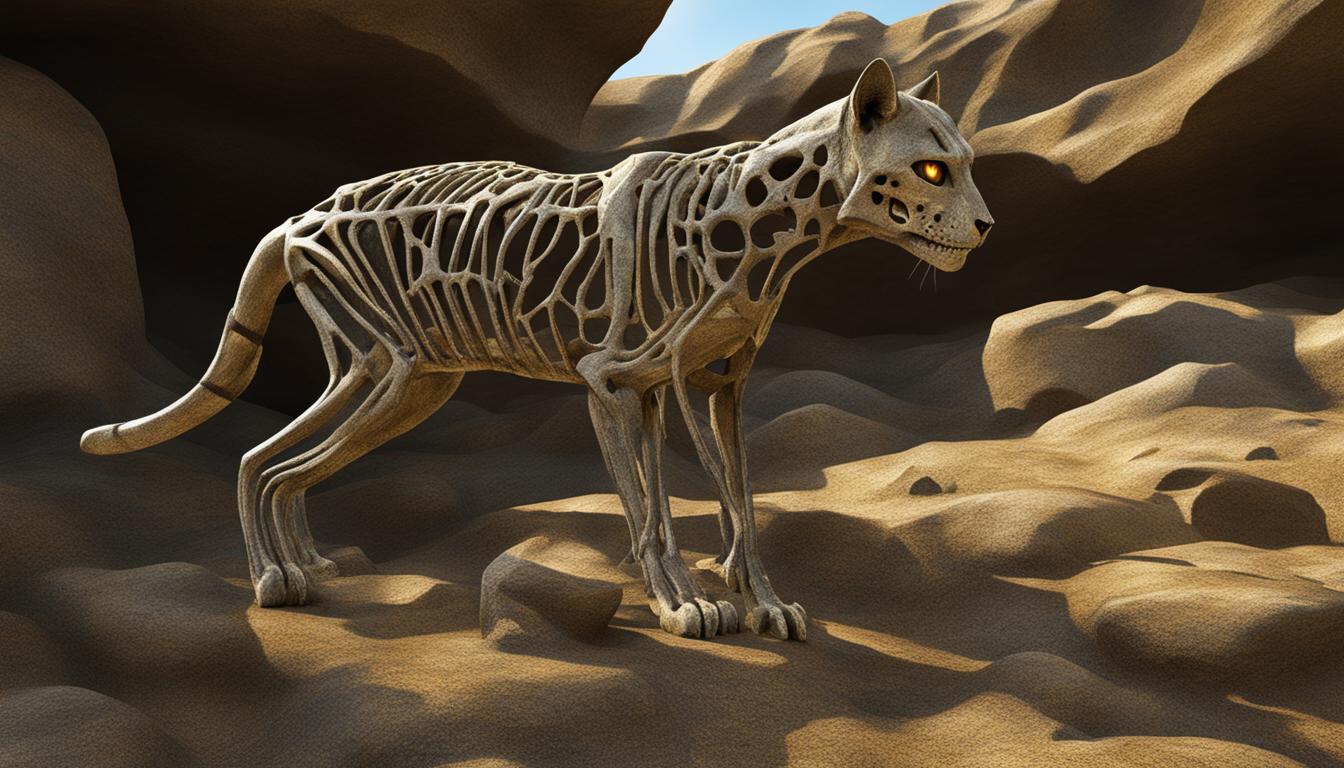Humans and cats, a relationship that has spanned thousands of years. As a feline enthusiast myself, I’ve always been intrigued by the deep connection between these mysterious creatures and us humans. In this article, we will delve into the fascinating history of cats as pets and explore how our attitudes towards them have transformed over time.
- The bond between humans and cats has evolved over thousands of years.
- Cats first began their relationship with humans as rodent hunters in the Fertile Crescent.
- Innovations such as refrigeration, kitty litter, and spaying/neutering made it possible to keep cats indoors.
- Cats have had a significant impact on human culture throughout history.
- Genetic studies have revealed changes in genes linked to the domestication of cats.
Origins of the Domestic Cat
Let’s delve into the fascinating origins of the domestic cat and uncover how they became such cherished companions throughout history. It all began in the Fertile Crescent region, where cats formed a unique bond with humans thousands of years ago. Originally, cats were drawn to humans due to the abundance of rodents attracted by stored grain. Over time, a new species of cat, felis catus, evolved naturally, making its home around humans.
Ancient evidence from Cyprus suggests that cats and humans were living side by side as far back as 9,500 years ago. This coexistence continued to expand as cats accompanied humans on their journeys, serving as invaluable mousers on ships and even becoming official employees of the United States Postal Service. Cats’ ability to adapt and thrive in various environments played a significant role in their long-standing companionship with humans.
Throughout their history, cats have proven to be more than just adept hunters. They have held special places in human cultures, being worshipped in ancient Egypt and even making appearances in literary works such as Geoffrey Chaucer’s The Canterbury Tales. Cats’ impact on society as both pest controllers and beloved companions is a testament to their innate charm and versatility.
| Historical Milestones | Impact |
|---|---|
| Ancient Egypt | Worshipped as sacred beings |
| 19th-century United States | Official employees of the United States Postal Service |
| Geoffrey Chaucer’s The Canterbury Tales | Featured in notable literary works |
As we unravel the mysteries of the cat-human bond, we gain a deeper understanding of the rich history behind our feline friends. From their humble beginnings in the Fertile Crescent to their global presence, cats have captivated our hearts and minds throughout the ages.
The Changing Role of Cats
The fascinating history of cats reveals an evolution in their role within human society. While cats were originally valued for their prowess as pest controllers, their status has shifted over time. Towards the end of the 19th century, people began to appreciate cats not just for their practical use, but also for their companionship. This change in perception was marked by the first cat show in 1895, which celebrated cats as house pets, highlighting their evolving role in human lives.
Throughout history, cats have left a lasting impact on human culture. In ancient Egypt, these enigmatic creatures were worshipped, revered as sacred companions. Cats have also made their mark in literature, with notable mentions in Geoffrey Chaucer’s iconic work, The Canterbury Tales. These historical instances showcase the influence cats have had on human society, transcending their initial role as rodent hunters.
As the adage goes, “Dogs have owners; cats have staff.” This playful quote encapsulates the unique nature of the feline-human bond. Cats bring joy, comfort, and companionship to countless households, enriching the lives of their human counterparts. Their presence is not solely utilitarian but deeply ingrained in the fabric of human existence. Whether it’s a warm purr or a playful swat, cats find ways to leave an indelible mark on our hearts.
While the appreciation for cats as indoor companions has grown, it’s essential to acknowledge their inherent nature to live outdoors. Biologically, cats retain their instincts and innate desire to explore the world beyond our homes. Therefore, responsible practices such as spaying/neutering and participating in trap-neuter-return programs can help strike a balance between their natural inclinations and their safety within human society.
The Table below provides a glimpse into the changing role of cats over time:
| Period | Main Role |
|---|---|
| Ancient Times | Pest control |
| 19th Century | Transition to companionship |
| Modern Era | Indoor pets and companions |
The Invention of the Indoor Cat
Throughout history, cats have been valued for their companionship and their ability to control pests. However, it was not until the 20th century that innovations made it possible for cats to live comfortably indoors.
Refrigeration, invented in the early 20th century, allowed humans to store food safely and eliminated the need for cats to supplement their diets with hunting. This meant that cats could be kept indoors without the risk of a nutritional deficiency. Additionally, the invention of kitty litter provided a convenient and hygienic solution for cats’ bathroom needs, further facilitating their transition to indoor life.
“The ability to keep cats indoors not only ensured their safety, but also provided a new level of convenience for cat owners,” explains Dr. Emily Johnson, a cat behavior expert. “Indoor cats have longer lifespans and are protected from the dangers of outdoor life, such as traffic accidents and exposure to infectious diseases.”
Another significant development in cat care was the widespread practice of spaying and neutering. This not only helped control the feral cat population but also eliminated the behavioral and health issues associated with reproduction.
Despite these advancements, it is important to remember that cats still retain their natural instincts and behaviors adapted to life outdoors. While they can thrive as indoor companions, providing enrichment and opportunities for physical and mental stimulation is essential to ensure their well-being. Interactive play, scratching posts, and access to windows for bird-watching are just a few ways to keep indoor cats happy and satisfied.

The Benefits of Indoor Living
| Benefits | Explanation |
|---|---|
| Protection from outdoor hazards | Indoor cats are not exposed to dangers such as traffic accidents, predators, and infectious diseases. |
| Longer lifespan | Indoor cats generally live longer than their outdoor counterparts due to reduced risks and access to consistent healthcare. |
| Reduced environmental impact | By keeping cats indoors, their impact on local wildlife populations is minimized. |
| Minimal disturbance to neighbors | Indoor cats are less likely to cause nuisance to neighbors, such as digging up gardens or spraying territory marks. |
By understanding cats’ natural inclinations and providing a stimulating indoor environment, we can ensure that our feline companions thrive and enjoy a safe and fulfilling life indoors.
The Genetic Roots of the Human-Cat Bond
Genetic studies have provided fascinating insights into the development of the bond between humans and cats. These studies have revealed that domestic cats, scientifically known as Felis catus, have undergone genetic changes compared to their wildcat ancestors. These changes are linked to motivation and fear, making domestic cats less shy and more driven by rewards. It is believed that these genetic adaptations have played a crucial role in strengthening the bond between humans and cats.
One notable genetic adaptation in domestic cats is their superior night vision and keen hearing, which have been honed over thousands of years. These adaptations were essential for their survival as hunters, but they also contribute to their ability to bond with humans. Cats’ exceptional senses allow them to perceive and respond to human communication and affection, further deepening the human-cat bond.
“Genetic studies have revealed changes in genes linked to motivation and fear in domestic cats compared to wildcats.”
It is important to note that cats have retained their independence and ability to survive in the wild. While they have developed a strong bond with humans, cats still possess their natural instincts and hunting skills. This is evident in the presence of feral cats in various environments, where they are able to adapt and thrive without human intervention.
| Genetic Adaptations | Impact on Human-Cat Bond |
|---|---|
| Changes in genes linked to motivation and fear | Improved socialization and bonding with humans |
| Superior night vision and keen hearing | Enhanced ability to perceive and respond to human communication and affection |
| Retained hunting skills and independence | Cats’ ability to survive in the wild |
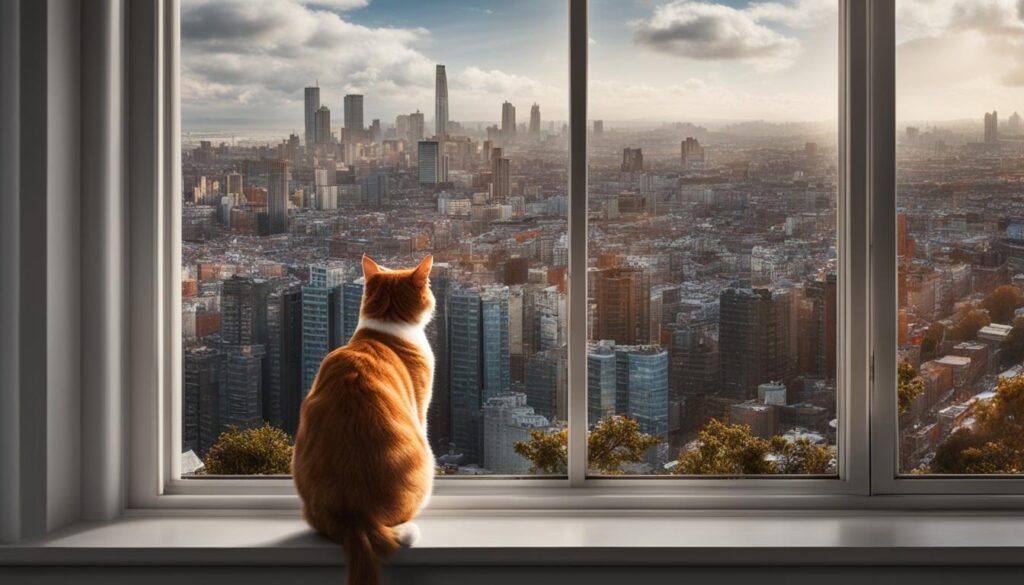
The Evolution of the Human-Cat Bond
The genetic roots of the human-cat bond provide a fascinating glimpse into the long-standing relationship between humans and cats. Over thousands of years, cats have evolved alongside humans, adapting to our environments and developing traits that enable them to form deep bonds with their human companions.
Understanding the genetic adaptations of cats not only enhances our appreciation for their unique qualities but also sheds light on the complex and multifaceted nature of the human-cat relationship. Cats’ genetic changes have not only made them more sociable and affectionate but also better suited to coexist with humans in our ever-changing world.
By recognizing and celebrating the genetic roots of the human-cat bond, we can further strengthen our understanding of these remarkable animals and foster even deeper connections with our feline friends.
The Beginning of Domestication
As I dive deeper into the history of cats as pets and their evolving roles in human society, I can’t help but wonder how the domestication of these furry companions first began. It is believed that around 9,000 to 10,000 years ago, in the Fertile Crescent, alongside the establishment of early human settlements, cats started their journey towards becoming our beloved companions.
During this time, humans began to settle down and cultivate crops, which attracted pests like house mice. Cats, with their instinctual hunting abilities, found a ready food source in these settlements. As they adapted to this new environment, cats that were more tolerant of living alongside humans were favored by natural selection.
Over time, this coexistence led to the proliferation of proto-domestic cats in villages throughout the Fertile Crescent. These cats formed the foundation of the special bond that would develop between cats and humans in the centuries to come.
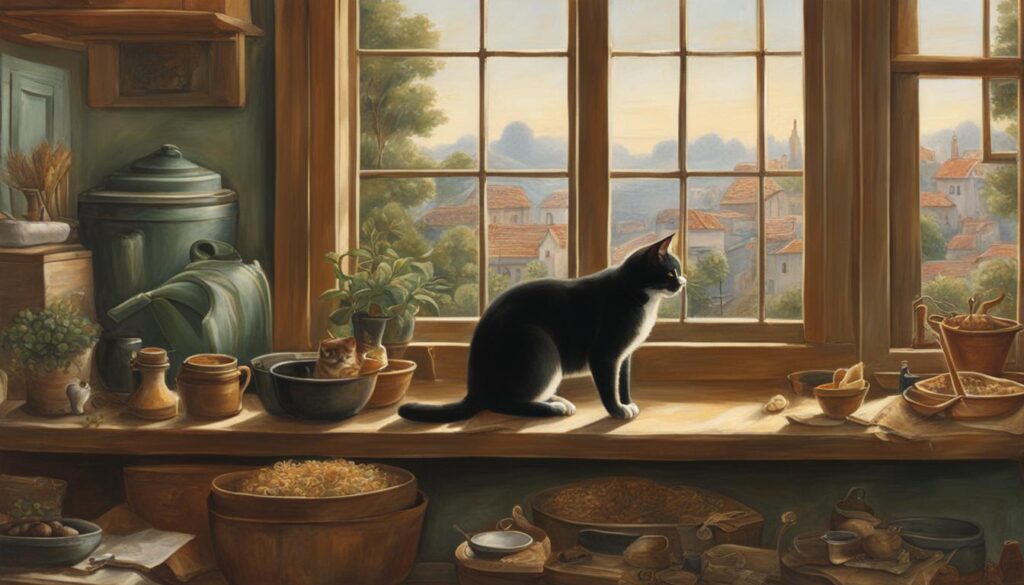
Mutually Beneficial Relationship
This early domestication of cats marked the beginning of a mutually beneficial relationship between cats and humans. Cats provided humans with pest control, helping to keep rodent populations in check. In turn, humans provided cats with a reliable food source and shelter.
As time went on, humans began to appreciate cats not only for their hunting prowess but also for their companionship. Cats became more than just working animals; they became valued members of households, offering comfort and affection.
“The bond between cats and humans has stood the test of time, evolving from a practical relationship to one of love and companionship.”
A Historical Footprint
The influence of cats in human culture throughout history cannot be overstated. From being worshipped in ancient Egypt to being mentioned in literature and folklore, cats have left their pawprints on our collective consciousness.
While cats have only become common indoor pets in the last century, their historical role as outdoor companions should not be overlooked. They have shaped how we view and interact with these fascinating creatures, making them an integral part of our society.
| Cats in Human History | Evolving Roles |
|---|---|
| Worshipped in ancient Egypt | From pest controllers to beloved companions |
| Official employees of the United States Postal Service | Contributing to human culture and literature |
| Present in various cultures as companions | Inspiring awe and fascination throughout the ages |
As I continue my exploration of the human-cat relationship, I am fascinated by the deep-rooted history that has shaped our bond with these incredible animals. From their humble beginnings as rodent controllers to their current status as cherished companions, cats have come a long way. The sequel follows as we examine the changing role of cats and how they have become an indispensable part of our lives.
The Long-standing Coexistence of Cats and Humans
Throughout history, cats have formed a unique and enduring bond with humans. From the early days of their partnership in ancient civilizations to the present, cats have played various roles in human society. While they have become popular indoor pets in recent years, it is essential to acknowledge their historical role as outdoor companions.
Since the time of ancient Egypt, cats have been revered and worshipped by humans. They were considered sacred and even had their own god, Bastet. Cats were believed to bring good luck and protection, and their presence in households was seen as a sign of prosperity. Their companionship provided comfort and joy to people, leading to their integration into human society.
Throughout the ages, cats have proven their usefulness to humans as well. They have been skilled hunters, keeping rodent populations in check and protecting stored grain from pests. Their presence on ships ensured the safety of valuable cargo by eliminating rats and mice. The United States Postal Service even employed cats as mousers to keep mailrooms free from rodents.
While cats have adapted to living indoors with the help of modern innovations, it is crucial to remember their natural inclination to roam and explore. This coexistence between cats and humans can be enhanced through responsible practices such as spaying/neutering and trap-neuter-return programs, ensuring the well-being of cats while respecting their instincts.
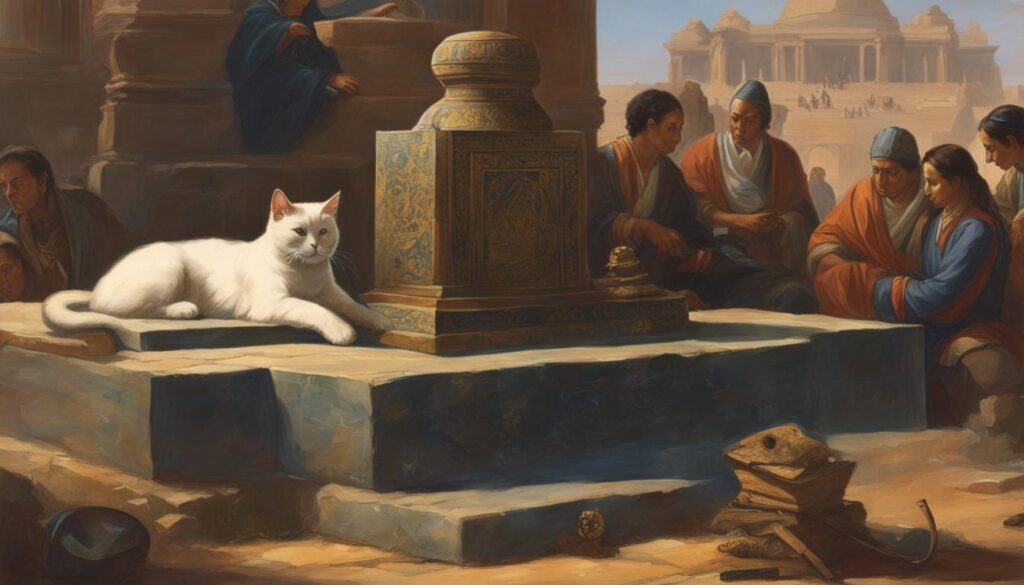
Ancient Egyptian Beliefs
The ancient Egyptians had a deep reverence for cats, considering them sacred and even worshipping them. Cats were seen as protectors, and their presence in households was believed to bring good luck and prosperity.
Valued Companions
Cats have provided companionship and joy to humans for centuries. Their presence has brought comfort, and they have become beloved members of many households.
Skilled Hunters
Cats have showcased their hunting prowess throughout history, keeping rodent populations in check and protecting valuable resources. They have served as efficient pest controllers both on land and at sea.
Conclusion
As I reflect on the fascinating history of the bond between humans and cats, it is evident that this relationship has evolved over thousands of years. Cats, once primarily pest controllers, have now become cherished companions in our lives. The introduction of innovations like canned cat food and cat litter has made it possible for cats to comfortably adapt to indoor living.
Genetic studies have brought to light the remarkable changes in domestic cats compared to their wild ancestors. These changes have influenced their behavior, making them less shy and more motivated by rewards. Cats’ superior night vision and acute hearing, developed over time, have made them exceptional hunters. Yet, despite their domestication, cats still retain their instinctual inclination to live outdoors.
It is important to recognize the evolving roles of domestic cats in human society. Throughout history, cats have been companions, worshipped in ancient Egypt, and mentioned in literature. However, we must also acknowledge their historical role as outdoor companions and work towards improving coexistence between cats and humans through responsible practices such as spaying/neutering and trap-neuter-return programs.
The human-cat relationship is a fascinating journey that continues to evolve. From their humble beginnings as rodent hunters in the Fertile Crescent to their beloved status in modern times, cats have left an indelible mark on our lives. Let us continue to nurture and appreciate this unique bond, ensuring the well-being of cats as they share our lives and homes in their own special way.
FAQ
How long have humans and cats had a relationship?
Cats have been living alongside humans for over 10,000 years.
Where did the relationship between humans and cats begin?
The relationship between humans and cats began in the Fertile Crescent region, around 10,000 to 12,000 years ago.
What were the initial roles of cats in human society?
Cats initially preyed on rodents attracted to stored grain, serving as pest controllers.
How did cats spread to different parts of the world?
Cats traveled with humans, including to ancient Egypt and Europe, where they served as mousers and were even worshipped.
When did cats become common indoor pets?
Cats only became common indoor pets in the 20th century, with the development of innovations such as refrigeration, kitty litter, and spaying/neutering.
What impact did cats have on human culture?
Cats were worshipped in ancient Egypt and have been mentioned in literature throughout history, such as Geoffrey Chaucer’s The Canterbury Tales.
How have genetic studies contributed to our understanding of the human-cat bond?
Genetic studies have shown changes in genes linked to motivation and fear in domestic cats compared to wildcats, suggesting genetic adaptations that contribute to their bond with humans.
Can cats survive independently of humans?
Yes, the presence of feral cats in various environments demonstrates that cats can survive independently of humans.
How has the role of cats evolved over time?
Cats have gone from being primarily pest controllers to beloved companions, with their roles expanding to include companionship and even employment in the United States Postal Service.
How can the coexistence between cats and humans be improved?
Responsible practices such as spaying/neutering and trap-neuter-return programs can help improve the coexistence between cats and humans.

